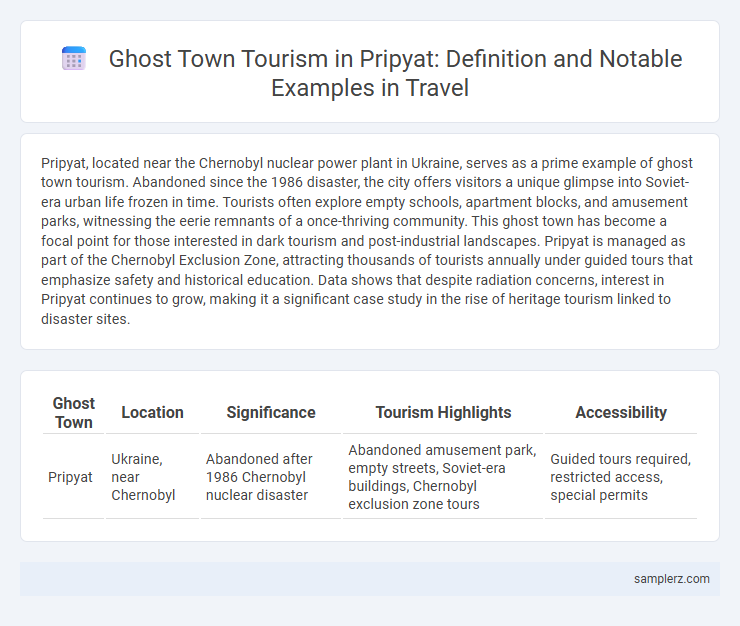Pripyat, located near the Chernobyl nuclear power plant in Ukraine, serves as a prime example of ghost town tourism. Abandoned since the 1986 disaster, the city offers visitors a unique glimpse into Soviet-era urban life frozen in time. Tourists often explore empty schools, apartment blocks, and amusement parks, witnessing the eerie remnants of a once-thriving community. This ghost town has become a focal point for those interested in dark tourism and post-industrial landscapes. Pripyat is managed as part of the Chernobyl Exclusion Zone, attracting thousands of tourists annually under guided tours that emphasize safety and historical education. Data shows that despite radiation concerns, interest in Pripyat continues to grow, making it a significant case study in the rise of heritage tourism linked to disaster sites.
Table of Comparison
| Ghost Town | Location | Significance | Tourism Highlights | Accessibility |
|---|---|---|---|---|
| Pripyat | Ukraine, near Chernobyl | Abandoned after 1986 Chernobyl nuclear disaster | Abandoned amusement park, empty streets, Soviet-era buildings, Chernobyl exclusion zone tours | Guided tours required, restricted access, special permits |
Exploring Pripyat: The Eerie Allure of a Ghost Town
Exploring Pripyat offers a unique glimpse into the chilling aftermath of the Chernobyl nuclear disaster, drawing travelers fascinated by abandoned spaces and history frozen in time. Visitors navigate through dilapidated Soviet-era buildings, deserted amusement parks, and overgrown streets, experiencing a haunting yet captivating atmosphere that epitomizes ghost town tourism. This site provides an unparalleled opportunity to witness the eerie allure of human evacuation and nature's slow reclamation in an iconic post-apocalyptic landscape.
A Brief History of Pripyat Before the Disaster
Pripyat, founded in 1970 as a model Soviet city, was built to house workers of the nearby Chernobyl Nuclear Power Plant and quickly became a bustling community with a population of nearly 50,000 residents. The city featured modern amenities, including schools, hospitals, theaters, and recreational facilities, exemplifying Soviet urban planning and lifestyle before its abrupt evacuation in 1986. Today, Pripyat remains an eerie ghost town, drawing tourists interested in the history of nuclear energy, Soviet-era architecture, and the tragic Chernobyl disaster.
Chernobyl Catastrophe: How Pripyat Became a Ghost Town
Pripyat, once a thriving city in Ukraine, became a ghost town following the Chernobyl nuclear disaster in 1986, when an explosion released massive radiation, forcing a rapid evacuation. Today, Pripyat is a key site for ghost town tourism, attracting visitors interested in exploring the eerie abandoned buildings, overgrown streets, and remnants of Soviet life frozen in time. The Chernobyl catastrophe remains the defining event shaping Pripyat's transformation into a haunting symbol of nuclear disaster and its long-lasting environmental impact.
Pripyat’s Most Notable Abandoned Attractions
Pripyat's most notable abandoned attractions include the rusting Ferris wheel in the central amusement park, the deserted Azure Swimming Pool, and the crumbling Palace of Culture "Energetik." These sites vividly capture the eerie stillness left by the 1986 Chernobyl disaster, drawing tourists interested in ghost town tourism. The decaying architecture and overgrown streets offer a haunting glimpse into Soviet-era life frozen in time.
Guided Tours in Pripyat: What to Expect
Guided tours in Pripyat offer an immersive experience into the abandoned Soviet-era city frozen since the Chernobyl nuclear disaster in 1986. Visitors can expect expert-led walks through eerie streets, exploring deserted buildings like the Amusement Park, schools, and apartment blocks while learning about the area's history and nuclear accident impact. Strict safety protocols, including radiation monitoring and restricted zones, ensure a secure visit during these unique ghost town expeditions.
Safety Measures for Visiting Pripyat’s Exclusion Zone
Visitors to Pripyat's Exclusion Zone must adhere to strict safety measures due to residual radiation and structural hazards. Authorized tours provide radiation monitoring devices, enforced by guides trained in contamination protocols to minimize health risks. Restricted zones are clearly marked, and access is controlled to ensure compliance with Ukrainian safety regulations during ghost town tourism.
The Role of Nature in Reclaiming Pripyat
Nature plays a crucial role in reclaiming Pripyat, where overgrown vegetation and wildlife have thrived since the 1986 nuclear disaster. Trees, plants, and animals have gradually engulfed abandoned buildings and streets, transforming the ghost town into a surreal, post-apocalyptic ecosystem. This natural reclamation creates a unique tourist experience, blending history with the remarkable resilience of the environment.
Photography Tips for Capturing Pripyat’s Haunting Beauty
Pripyat's abandoned buildings and overgrown streets offer striking contrasts for photographers seeking eerie beauty, with natural light casting shadows that enhance the town's haunting atmosphere. Use wide-angle lenses to capture expansive views of decaying structures and incorporate foggy or misty weather conditions to add a layer of mystique to images. Focus on details like rusted playgrounds and peeling paint to convey the passage of time and evoke emotion in ghost town tourism photography.
Ethical Considerations in Ghost Town Tourism
Tourism in Pripyat, a ghost town abandoned after the Chernobyl nuclear disaster, raises significant ethical considerations including respect for victims, environmental preservation, and cultural sensitivity. Visitors must adhere to safety protocols and avoid disturbing the site's remains to honor the tragic history and prevent ecological damage. Responsible ghost town tourism promotes awareness and education while ensuring the dignity of the affected communities and landscape is maintained.
Pripyat’s Enduring Legacy: Lessons from the Past
Pripyat's ghost town tourism offers a haunting glimpse into the aftermath of the 1986 Chernobyl nuclear disaster, preserving the memory of a once-thriving Soviet city abruptly abandoned. Visitors witness the skeletal remains of schools, amusement parks, and residential buildings, which vividly illustrate the consequences of technological catastrophe and human error. This enduring legacy provides crucial lessons on nuclear safety, environmental resilience, and the importance of disaster preparedness.

example of ghost town tourism in Pripyat Infographic
 samplerz.com
samplerz.com